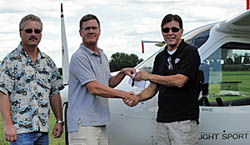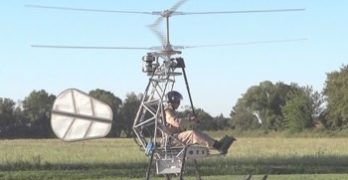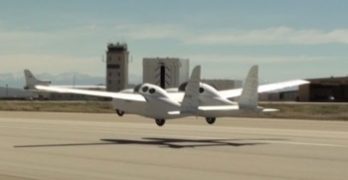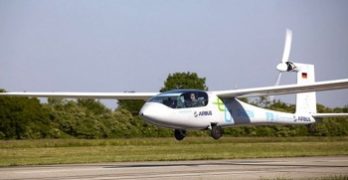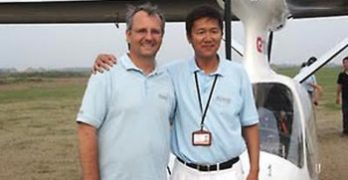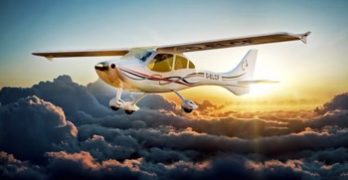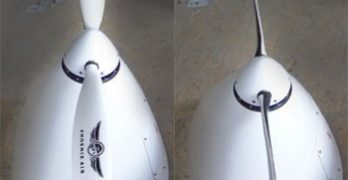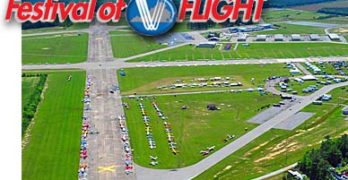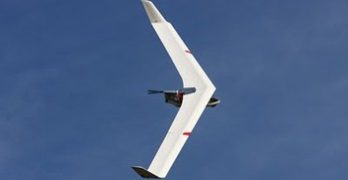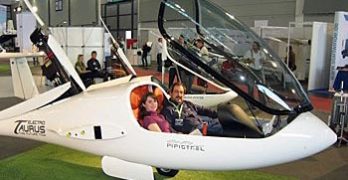Light-Sport Aircraft can be working aircraft (think: flight instruction and rental, each potentially a commercial activity) but read about this new twist. *** Recently, Flight Design USA delivered a customized Light-Sport Aircraft to a sheriff’s department in California. A CTLS fitted with police camera, radios, and custom controller was dubbed CTLE for “Law Enforcement.” The specially equipped CTLS was completed at Flight Design USA headquarters. Near the end of August 2011, two police officers from Tulare County, California traveled to Connecticut and then flew the special LSA back across the country. *** Commonly police departments have used helicopters or larger general aviation aircraft for activities like surveillance work. Helicopters are especially expensive… to buy, to operate, and to maintain. Realizing this, Flight Design USA’s big distributor, Airtime Aviation worked with Roger Crow of Echo Flight Resources on a second CTLE modified with a pod for the CTLS right wing.
Search Results for : flight design ct
Not finding exactly what you expected? Try our advanced search option.
Select a manufacturer to go straight to all our content about that manufacturer.
Select an aircraft model to go straight to all our content about that model.
Electric Whirlybird Flies!
Anyone still in doubt that we’re in the midst of the birth of electric flight need look no further than this story, just posted today on the online tech zine Gizmag.Pascal Chretien, an enterprising electrical/aerospace engineer and chopper pilot, made the world’s first fully electric helicopter flight in the prototype he designed and built almost entirely by himself… in just 12 months! Hang glider and ultralight trike pilots will delight in hearing a weight shift control system is involved. *** For me, the big story here is once again we see that innovation lives, not just in megabuck corporate and government R&D departments but in the garages of individual megabrains as well…as it always has and we can expect always will.Chretien, in making his 2 minute, 10 second test eggbeater flight, threw whipped eggs in Sikorsky’s face since that aviation giant’s well-funded electric project, in development for some time now, has yet to fly.
Another Roadable Aircraft Project!
Okay, so no way this is ever going to be a Light Sport aircraft, but this is just too much fun and I had to pass it along. *** Famed aircraft designer Burt Rutan has been at it again, this time with his eclectic take on a flying car that began life as an electric-powered flying testbed. *** Aviation Week’s online blog (also picked up by Wired magazine) shared information released exclusively to it by Rutan’s Scaled Composites company known in recent years for many fantastic projects including Spaceship One and White Knight. *** Called BiPod, the flying car became a crash program, completed in just four months and already in test flight mode. Rutan himself retired in April of this year. *** Model 367 BiPod is characteristically, wonderfully unconventional as have been all of Rutan’s many designs. *** The two-seat, hybrid-electric “roadable” aircraft (mini-rant: I sure hope that term doesn’t replace flying car, which flows off the tongue much more agreeably, don’t you think?), originally conceived as a fast, inexpensive electric aircraft, morphed into a flying car.
eWow! Blockbuster Electric Flight
A crack team of aeronautical whizbrains in the Institute of Aircraft Design at the University of Stuttgart, Germany has just passed its second important milestone in less than two months: its electric aircraft eGenius just flew more than two hours at more than 100 mph. *** Not by coincidence, that’s exactly the kind of performance that will be required to take $1.3 million top prize in the recently postponed (until September 25) CAFE Green Flight Challenge. *** The GFC will award the prize money to the aircraft that can fly 200 miles at greater than 100 mph on the equivalent of one gallon of gas per occupant. The per occupant proviso is significant…and EGenius carries two people, so it can use enough batteries to store two gallons worth of energy. *** That’s a lot of batteries given the current relative inefficiency of energy storage of batts vs.
Electric Prototype and Pilot Lost
As I write an article on the current state of electric flight worldwide, sad word comes that prolific, talented German aeronautical engineer Martin Wezel has died in the crash of the prototype Yuneec International E1000 electric airplane. *** Wezel’s company, Flugzeugtechnik Wezel, was well respected for its gliders and microlights, which included the Sting and Sirius SLSA. His Apis and Viva designs were also being developed by Yuneec for electric power. The E1000 design may also have been Wezel’s. *** A new, tandem-motored four-seat design, it was being developed for market by Yuneec but also to compete in the NASA CAFE Green Flight Challenge, the $1.65 million-prize competition that’s coming up in July. *** E1000 was also entered in EAA’s upcoming Electric Aircraft Competition (Oshkosh 2011 in late July). Not evident at this point is whether another E1000 was built or will be tested.
Flight Design 4-Seater Heading To Market
Although this isn’t an LSA story per se, it comes out of Flight Design, the top-notch, top-selling LSA company in America, so I thought you’d be interested to know the company debuted its C4 4-seater at Aero last month and just came out today with some pricing and delivery numbers along with some specs. *** Perhaps the most interesting number to me is the $250,000 “target” price for the American market, along with a €220.000 price for Europe and the rest of the world outside the U.S. *** When’s the last time we saw a new, state-of-the-art 4-seat airplane at a price close to that? *** Also noteworthy is the minimal disparity between the overseas and U.S. prices, reflecting the company’s desire to minimize (yea verily, to almost negate!) the currently soaring euro/dollar exchange rate imbalance. *** Some interesting details about the all-carbon fiber composite airplane: • Engine choice: two engine options to best suit fuel availability and cost in the owner’s region: either a traditional aviation engine that can run on auto fuel, or a turbo diesel engine that burns Jet A fuel.
“Spy Network” Report: Twin Electric Sailplane
I heard again today from Jim Lee who’s still overseas helping prep the PhoEnix electric motorglider for July’s big, $1.65 million CAFE Green Flight Challenge (GFC) fuel-efficient flight competition in Santa Rosa, CA. *** Jim sent along photos of the electric nosecone with integrated feathering prop/spinner assembly. First test flights of the PhoEnix are planned in a couple weeks. *** BTW, the enhanced streamlining afforded by the much smaller e-motor boots the lovely creature’s performance from L/D 32:1 to 36:1 — a 12.5% increase! That’s great for soaring and also means less power required to sustain flight, the Big Picture for endurance at this stage of electric aviation. *** The GFC PhoEnix entry will be powered by a 44 kW motor and controller developed in house by Phoenix Air. *** Lipo (lithium polymer) batteries, popularized by the RC model industry for their light weight and high storage capacity, will hold the electric “gas”.
Virginia Festival of Flight Starts April 30
I have more to report from Aero 2011 in Europe, but let’s take a quick jaunt back across the Atlantic for an upcoming event of interest to LSA fans… The 14th Virginia Regional Festival of Flight runs April 30 and May 1, 2011 and it offers special opportunities for the Light-Sport crowd. *** Public Relations Chairman Dee Whittington, noted, “As usual we’ll have a dedicated [light aircraft] runway and parking area. Also, most of our manufacturers who will attend are from the Light-Sport community.” He continues with a bit of very important info both to vendors and those pilots wanting to carefully check out a LSA with a demonstration flight, “A good feature of our full-featured fly-in is the ability of vendors to do demo flights during the day instead of waiting until after 5:00 PM when the event shuts down.” Major airshows like AirVenture and Sun ‘n Fun have windows for free flying that restricts the number of demo flights aircraft sellers can provide (although Sun ‘n Fun offers Paradise City as an on-site alternative which can insure more such purchase evaluation flights).
Electric Flight: More Thoughts
Yesterday a reader commented on my electric flight post, specifically about the LZ FES, a pretty sexy add-on that just won the Lindbergh LEAP prize for best new electric propulsion system. He wondered whether electric flight for now required light weight motorgliders or whether heavier, 15M plus sailplanes/motorgliders would be workable for electric power. *** My answer began to get too lengthy to stick in comments so I’m posting it here, and thanks Thomas for your enthusiasm. *** I talked over this very subject this week with Randall Fishman, the award-winning electric flight pioneer. His take on where we’re at right now is in my Profiles in Vision column, coming in the July issue of P&P. *** Randall’s whole trip is to get people up in the air with electric power right now, and not for 150,000 clams either. To summarize his own one-man research and development plan, it’s all about lightweight motorgliders.
LEAP Awards Electric Aviation Prizes
Eric Lindbergh, grandson of Charles A. Lindbergh, awarded the LEAP Prize to Pipistrel’s Ivo Boscarol at the just-finished Aero General Aviation convention in Friedrichshafen, Germany. *** The 3rd annual e-Flight gathering took place there also, and Lindbergh’s Best Electric Aircraft award went to Pipistrel’s Taurus Electro. *** There were some notable challengers in the category and three finalists: the Taurus, the Electric Cri-Cri (power by Electravia), and Eric Raymond’s Sunseeker II solar airplane. *** Also awarded was the Best Electric Propulsion. The two finalists were the LZ Design FES (Front Engine Sustainer) system and the Rapid 200 Fuel Cell propulsion system from Polytechnic Torino. *** The LZ FES was the winner. *** The LEAP 2011 Outstanding Achievement Award went to Bertrand Piccard, Andre Borschberg and the Solar Impulse Team for its electric around-the-world project airplane. *** A romantic, and apt, spin on the awards is linking today’s electric pioneers to Lucky Lindy’s amazing transatlantic flight in 1927, which pretty much singlehandedly changed the global perception of aviation from a daredevil hobby or foolhardy mail delivery system to the common transportation, recreational and warfare tool it has become.
- « Previous Page
- 1
- …
- 16
- 17
- 18
- 19
- 20
- …
- 145
- Next Page »


